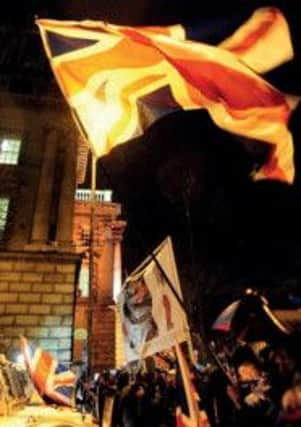City demonstrations and jailing of protestor figure in flags report


‘The Flag Dispute: Anatomy of a Protest,’ which has been newly-published by the Institute for the Study of Conflict Transformation at the Queen’s University, Belfast, also suggests that the “most effective message” sent to protest organisers about what was and wasn’t acceptable in terms of the demonstrations was a jail term handed to a Londonderry man convicted of blocking a road in early 2013.
The report - penned by Paul Nolan, Dominic Bryan, Clare Dwyer, Katy Hayward, Katy Radford and Peter Shirlow - also suggests, incorrectly, that the late East Londonderry unionist David McClarty left the Ulster Unionist Party (UUP) over its approach to the flag protests.
Advertisement
Hide AdAdvertisement
Hide AdHe, in fact, left long before the flag protests, as a result of his deselection as an Assembly candidate by the UUP.
Elsewhere, the authors say working-class Protestants, including paramilitary elements, in Londonderry, ended up by way of the flag protests, entering into unexpected engagements as a result of liaisons with community outreach workers.
In January 2013 several flag protests were held in the North West - including at Dale’s Corner and Newbuildings.
There was also a ‘Unionist Civil Rights Rally’ at Ebrington on the same day as the annual Bloody Sunday march.
Advertisement
Hide AdAdvertisement
Hide AdThe new report says “there was never one huge rally on the scale of the protest against the Anglo-Irish Agreement in 1985 when over 200,000 gathered at Belfast City Hall” but instead widespread protests all over the province.
“Giving evidence to the House of Commons Northern Ireland Committee on January 24 the Chief Constable Matt Baggott explained that on one particular evening there were 84 seats of protest, and that in one single week up to 10,000 people had taken part in protests.
“To take the example of a single day, on January 25, 2013, protests took place not only across Belfast but also in Antrim, Ballyclare, Ballymoney, Carrickfergus, Dundonald, Dunmurry, Glengormley, Larne, Newtownabbey, Whitehead, Ballynahinch, Bangor, Greyabbey, Kilkeel, Coleraine, Garvagh, Magherafelt, Derry-Londonderry, Newbuildings and Portadown,” the authors state.
At the time East Londonderry MP Gregory Campbell said public sector jobs for Protestants, parading disputes and ‘cultural differentials’ between Ulster Scots and the Irish language were some of the factors underpinning the protests.
The new report acknowledges some of these factors.
Advertisement
Hide AdAdvertisement
Hide AdIt also wrongly suggests Mr Campbell’s late East Londonderry colleague at Stormont, David McClarty, left the UUP as a result of its flag policy.
“The big tent approach of the Unionist Forum did not only leave radical protestors on the outside. It also alienated and isolated sections of the liberal wing of the UUP notably Basil McCrea, John McCallister and David McClarty who were to leave because of their party’s approach to the flags issue and its increasingly close relationship with the DUP,” it states.
The late Mr McClarty actually left the UUP because he was deselected as an election candidate in the 2011 Assembly elections. He eventually won his seat as an Independent with twice as many votes as UUP choice, Lesley Macaulay.
Meanwhile, the report says a strong message was sent to the protestors when a Londonderry man was given a jail term for blocking a road.
Advertisement
Hide AdAdvertisement
Hide Ad“The legal niceties were explained to loyalist leaders, but perhaps the most effective message came on January 23 when Daniel Baronowski from Newbuildings in Derry-Londonderry became the first person sent to prison for blocking a road.
“Sentencing him to two months imprisonment the district judge told him: ‘People have no right to block roads, and no right to disrupt the lives of other people.’”
Whilst the protests gained a momentum of their own, which apparently discomfited loyalist paramilitary leaders - “there was sympathy for the protestors, but concern about the uncontrollable nature of events” - in Londonderry there were some positive outworkings.
“There were other examples of the flag protests taking working-class Protestants into unexpected engagements,” the report suggests.
Advertisement
Hide AdAdvertisement
Hide Ad“In Derry-Londonderry, for example, flag protesting that included paramilitary elements led to meetings with local community outreach workers.
“The positive development was that the protestors subsequently became involved in inter-community events such as the Fleadh as part of the City of Culture events,” it adds.